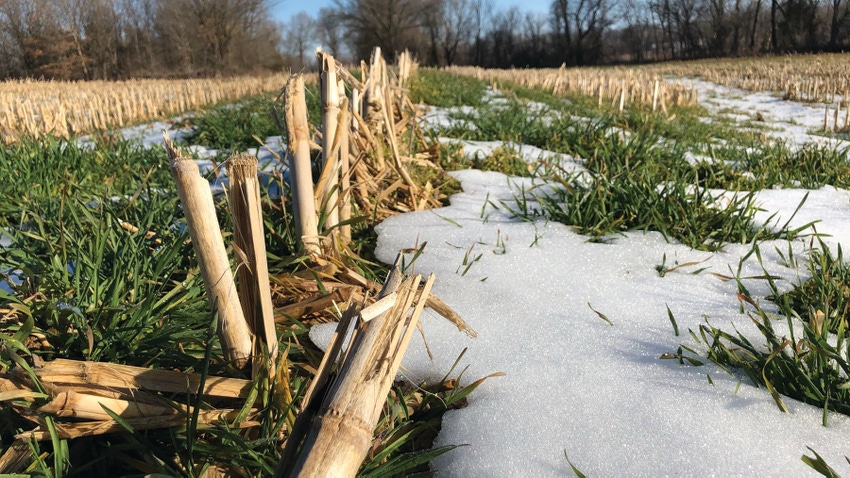
At a Glance
- Winter temperatures won't lessen insect pressure this season.
- Northeast Mississippi could see slightly lower pressure from redbanded stinkbugs.
- Increases in corn acres could drive up cotton insect pressure.
If you think using enough water to thoroughly push insecticide into every nook and cranny of your crop is tough, try reaching burrowing insects with temperatures cold enough to freeze them into submission.
That’s a feat Mother Nature doesn’t quite accomplish more years than not in the lower South. And 2023 appears to be one of those years when the insects won. The seemingly bitter cold snaps in late 2022 and early this year didn’t provide freezing temperature low enough for long enough to kill substantial numbers of damaging insects in most parts of Louisiana and Mississippi.
“In north Mississippi, it got cold enough long enough that we would have thought that the weather would have an impact on redbanded stinkbug populations,” said Whitney Crow, Mississippi State Extension entomologist, speaking in early May. However, Mississippi’s redbanded stinkbug survey showed the pest was already showing up in clover and other host plants at noticeable populations early this year. Based on those survey results, Crow said, “I don’t think that the weather at this point has had a measurable impact on our populations.
“The difference is the recorded air temperatures and how cold it was in the duff – that organic layer of soil that provides shelter to many insects, said LSU Ag Center Entomologist Jeff Davis. He noted that temperatures lower than 23 degrees for seven hours or more will kill 90% of exposed redbanded stinkbug populations. The keyword is exposed.
“If the cold can get to them, they’ll die. The years when it gets cold down into the teens and into that duff layer, it will definitely kill them,” Davis said. “We did get some cold, and it did set them back a little bit, but it didn’t get cold enough to really set them back,” Davis said. “It was not as cold as the big cold snaps of 2011/2012, or the ice storm in 2021.”
Expect insect pressure
The only geography in Mississippi that may see lower pressure from the redbanded stinkbug is the upper northeast part of the state. “We haven’t found them there – not to say they aren’t there,” Crow said, but as of early May Extension researchers hadn’t yet found them.
That corner is crop consultant Tucker Miller’s hunting grounds. Based in Drew, Miss., Miller suspects the redbanded stinkbug may be a little less noticeable in soybean fields in his area of northeast Mississippi.
“In my area, I think we’ll probably be OK on redbanded stinkbug,” Miller said, speaking in mid-May. However, he said, “the further south you go, the worse you are. I would not put all my money on insects being lighter because it was cold this winter. You have to keep scouting.”
For soybean producers, redbanded stinkbug is the pest highest on the list of concern to soybean producers in Mississippi and Louisiana.
“We will likely see redbanded stinkbugs in soybeans, and especially in late-planted soybeans, this year,” Crow said.
The weather that may have a greater impact on the whole complex of stinkbugs is the rainy spring.
““It wasn’t as cold, but at the same time, our spring wasn’t as warm,” Davis said. “We have a wide range of planting dates. It’s just a smorgasbord for stinkbugs.”
Scout early and often
In fact, Davis recommends scouting early. “With the cold and rainy spring, we didn’t have crops in the ground as early as usual, so insects weren’t as active,” he said. “They’re around and if a crop gets stalled because of weather conditions, the plants are exposed to those insects longer.”
Cotton farmers have an even lower chance of freezing out their number one pest: plant bugs.
“Plant bugs are just always there,” Miller said.
Crow and Davis agree.
“They live in most of North America, so they’re a little harder to push back with cold weather,” Crow said.
Of greater concern in Miller’s area and many other counties across the state is an increase in corn acres over cotton plantings.
“With less cotton and more corn, that’s going to fuel the corn earworm and plant bugs in cotton as the corn dries down,” Miller said. “We have a good insect nursery all around our cotton acres.”
Bollgard 3 cotton varieties likely will hold off bollworm, Miller said, but “we’ll always have to keep an eye on it to be sure.”
Watch for fall armyworms
Fall armyworm showed up in some refuge corn early this year, but Davis hadn’t seen damaging populations in varieties traited to resist that pest.
“One farmer did have to spray, just so he could keep his refuge around for resistance management,” Davis reported.
Overall, the message is the same one repeated year after year: scout early and often.
Heavy stinkbug pressure across most of the state in 2022, cold that wasn’t quite cold enough, and a rainy spring that scattered planting dates are adding up to a busy season for insect management, Davis said.
Davis predicted: “It’s going to be a continuous wave of stinkbugs coming across.”
And they’re likely to have friends for company.
About the Author(s)
You May Also Like






